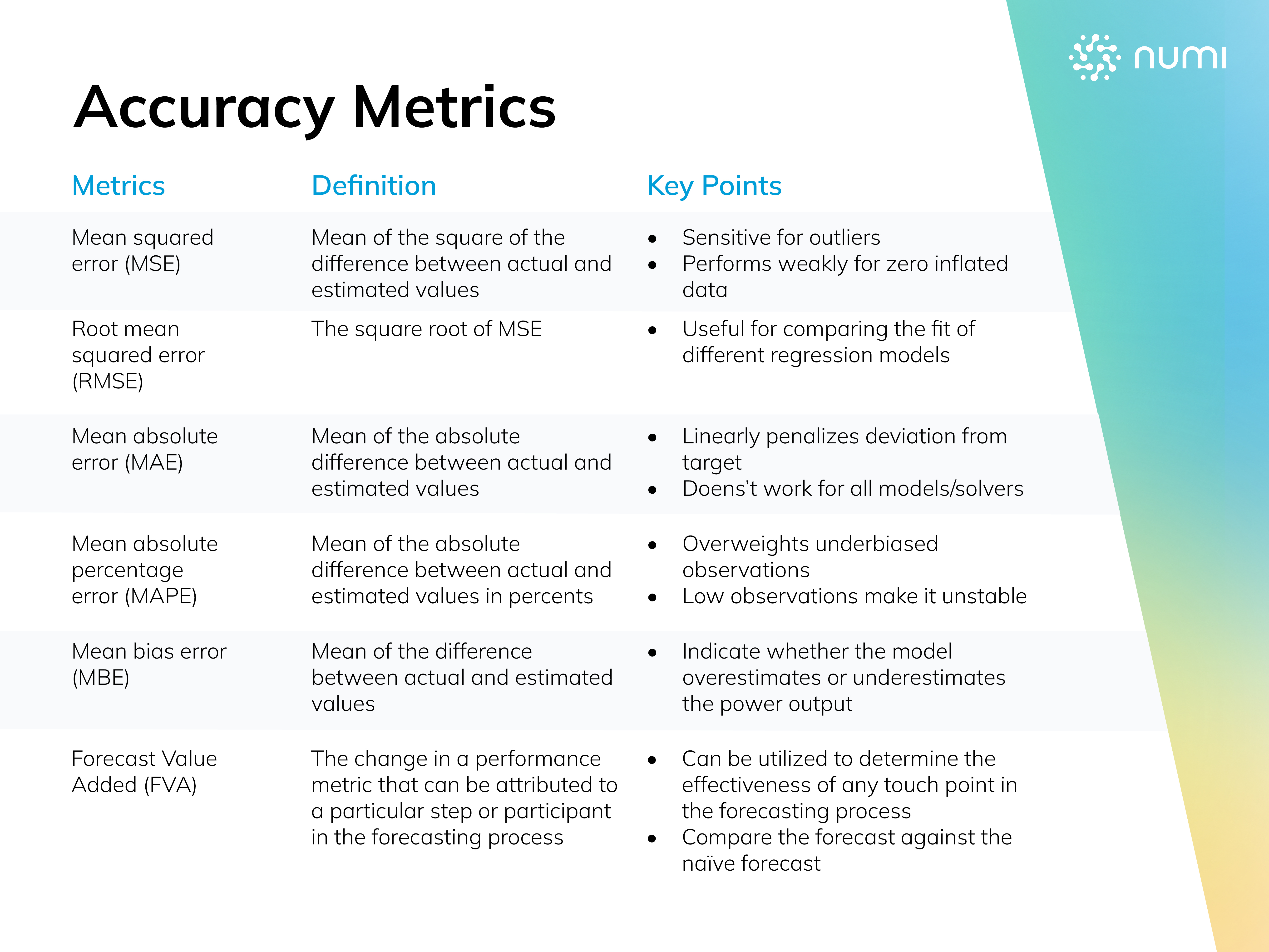
Forecast KPIs: Business success through forecast accuracy

Yulia Fedorova
21 Jun 2024
In the intricate landscape of modern business, the ability to anticipate and strategically plan for the future is not just an advantage; it's a necessity. Forecast Key Performance Indicators (KPIs) stand at the heart of this endeavor, serving as the compass by which companies navigate the uncertain waters of market demand, supply chain complexities, and evolving consumer behaviors.
By understanding and effectively tracking forecast KPIs, organizations can unlock insights into future trends, better align their resources with anticipated demand, and ultimately, forge a path toward financial resilience and growth.
Tracking and managing forecast KPIs can provide companies with several strategic benefits:
- Data-Driven Insights: Forecast KPIs provide valuable data that can help companies make informed decisions about resource allocation, market strategies, and operational improvements.
- Resource Optimization: Accurate forecasting helps in optimizing inventory levels, reducing waste, and ensuring that resources are used efficiently.
- Budget Accuracy: Forecast KPIs enable more precise financial planning and budgeting, helping companies allocate funds more effectively.
- Market Responsiveness: Companies that effectively track and manage forecast KPIs can respond more quickly to market changes, giving them a competitive edge.
- Customer Satisfaction: Accurate demand forecasting ensures that companies can meet customer demand without overproducing, leading to higher customer satisfaction and loyalty.
Challenges in tracking forecast KPIs
Managing and measuring forecast KPIs involves several challenges that can impact the accuracy and reliability of the forecasts. Firstly, data quality and integrity are major issues. Inconsistent data sources can lead to discrepancies, while incomplete or missing data points can result in inaccurate KPIs. Ensuring data accuracy is essential because errors can significantly skew the results of the forecasts.
The complexity of selecting and defining the right KPIs is another challenge. It's crucial to choose KPIs that are relevant and aligned with the business objectives. However, identifying these KPIs can be difficult, and there is often a risk of selecting too many, which can dilute focus and create confusion.
Monitoring and maintaining KPIs over time also pose significant difficulties. Businesses must continuously collect and analyze data to ensure KPIs remain relevant and accurate. This requires robust systems and processes, which can be resource-intensive. Additionally, regular updates to KPIs are necessary to reflect changes in business strategy or market conditions, which adds to the complexity.
Interpreting and communicating KPI results effectively is another common problem. Different stakeholders may have varying levels of understanding and interest in the KPIs, making it challenging to present the data in a way that is meaningful to everyone. Ensuring that all relevant parties understand and trust the KPI measurements is crucial for effective decision-making.
Types of metrics to evaluate forecasting process
Forecast Accuracy
Forecast accuracy is a measure of how close the forecasted values are to the actual outcomes. High accuracy in forecasts is essential for effective planning and decision-making. Here are some examples of forecast accuracy indicators:
- Forecast Accuracy Percentage (FA): It is a direct measure of forecast precision and is expressed as a percentage. The higher the percentage, the more accurate the forecast. Usually it’s defined as 1-MAPE.
- Mean Absolute Percentage Error (MAPE): Expresses the mean absolute error as a percentage of actual values, providing a normalized measure of accuracy.
- Mean Absolute Error (MAE): Measures the average magnitude of errors in a set of forecasts, without considering their direction.
- Root Mean Squared Error (RMSE): Measures the square root of the average of squared differences between forecasted and actual values. It gives a relatively high weight to large errors.
- Mean Squared Error (MSE): Calculates the average of the squares of the errors. Like RMSE, it penalizes larger errors more heavily.
Forecast Bias
Forecast bias refers to a consistent deviation of forecasted values from actual outcomes in a particular direction, indicating a systematic error in the forecasting process.
- Positive Bias: Occurs when forecasted values are systematically higher than the actual outcomes. It indicates an overestimation.
- Negative Bias: Occurs when forecasted values are systematically lower than the actual outcomes, indicating an underestimation.
- Tracking Signal: A method used to detect bias over time by comparing cumulative forecast errors against predetermined acceptable limits.
Forecast Value Added (FVA)
Forecast Value Added is a metric that assesses the contribution of each step in the forecasting process to the overall accuracy of the forecast. The idea is to identify steps that do not add value or even degrade the forecast, to streamline the process.
- Positive FVA: Indicates that a particular step or activity in the forecasting process adds value, improving forecast accuracy.
- Negative FVA: Indicates that the step or activity detracts from forecast accuracy. Identifying and eliminating these steps can streamline the forecasting process and improve results.
- Zero FVA: Suggests that the step or activity neither adds nor detracts from forecast accuracy. These steps may still be necessary for reasons other than accuracy improvement.

Definition and importance of forecast accuracy and bias KPIs
Forecast Accuracy (FA)
Definition: Forecast Accuracy is a measure that quantifies the precision of a company's sales or demand forecasts by comparing them to actual sales or demand. It is commonly expressed as a percentage and is calculated using the formula: (1-|Forecast
- Actuals|/Actuals) * 100. This metric assesses the ability of a company to predict future demand or sales accurately.
Importance: Forecast Accuracy is crucial for efficient inventory management, production planning, and resource allocation. A high level of forecast accuracy enables companies to optimize inventory levels, minimize stockouts, and reduce carrying costs. Additionally, it supports better decision-making in areas such as production scheduling and procurement. Improved forecast accuracy can lead to cost savings and enhanced customer satisfaction through better product availability.
Data Required:
- Forecasted sales or demand
- Actual sales or demand
- Time period for the comparison (e.g., monthly, quarterly)
- Product or SKU-specific sales or demand data
- Historical forecast data for comparison
- Any factors or events that may have influenced deviations between forecasted and actual sales or demand
Moreover, incorporating qualitative inputs from sales teams, market trends, and customer behavior can enhance the understanding of deviations and facilitate more accurate forecasting in the future.
Forecast Bias
Definition: Forecast Bias is a metric that evaluates the tendency of a company's forecasts to consistently overestimate or underestimate actual sales or demand. It is calculated using the formula: (Forecast/Actuals - 1) * 100. This metric provides insight into the direction and magnitude of forecasting errors, indicating whether forecasts are consistently optimistic or pessimistic.
Importance: Forecast Bias is important for understanding the systematic tendencies in forecasting accuracy. Identifying and addressing forecast bias is crucial for improving forecast accuracy and making informed business decisions. Recognizing whether forecasts consistently overstate or understate actuals can help in adjusting inventory levels, production planning, and resource allocation to align with more realistic expectations.
Data Required:
- Forecasted sales or demand
- Actual sales or demand
- Time period for comparison (e.g., monthly, quarterly)
- Product or SKU-specific sales or demand data
- Historical forecast data for comparison
- Any contextual information or events that may have influenced forecast biases
Techniques for improving forecast accuracy
Incorporating advanced analytics and machine learning
Advanced analytics and machine learning are pivotal in enhancing forecast accuracy. By utilizing machine learning algorithms, businesses can process and analyze vast amounts of data, identifying patterns that are not apparent to human analysts. These technologies allow for the adaptation to new data, ensuring that forecasting models remain relevant over time. AI and ML not only automate data processing but also improve the precision of predictions by learning from continuous data inputs, thereby optimizing forecasting efforts.
Utilizing market research and customer insights
Market research is essential for refining forecasting accuracy as it provides deep insights into consumer behavior and market trends. By analyzing customer feedback, purchase patterns, and market dynamics, companies can make informed predictions about future demand. This process is supported by gathering both qualitative and quantitative data through surveys, interviews, and analysis of consumer behavior, which helps businesses understand the nuances of market demand and adjust their forecasts accordingly.
Introducing collaborative forecasting
Collaborative forecasting enhances forecast accuracy by integrating insights from various stakeholders, including sales, marketing, and customer service teams. This approach allows for a more comprehensive view of market conditions and customer needs. By sharing information across departments and with external partners, businesses can align their inventory and production plans more closely with actual market demand. Collaborative efforts lead to improved accuracy in forecasts, better inventory management, and enhanced customer satisfaction due to more reliable supply chain operations.
The broader implications of accurately tracking and managing forecast KPIs extend into significant operational efficiencies and financial health for enterprises. As businesses strive to align their production with market demands accurately, the demand for advanced analytics and collaborative forecasting approaches becomes ever clearer. This shift towards data-driven forecasting is not just a trend but a fundamental change in how businesses position themselves for future growth and sustainability. Hence, as we navigate the complexities of market dynamics, the continuous improvement and application of forecasting accuracy and the conscientious management of KPIs stand as a testament to a business's resilience and adaptability in the face of change.
In conclusion, understanding and effectively tracking forecast KPIs is crucial for organizations aiming to unlock insights into future trends, better align their resources with anticipated demand, and ultimately, pave the way for financial resilience and growth. By leveraging data-driven insights, optimizing resources, ensuring budget accuracy, responding swiftly to market changes, and enhancing customer satisfaction, companies can significantly benefit from managing their forecast KPIs.
Ready to transform your forecasting process and drive your business towards greater accuracy and efficiency? Discover how numi can help you achieve these goals with our advanced forecasting solutions.